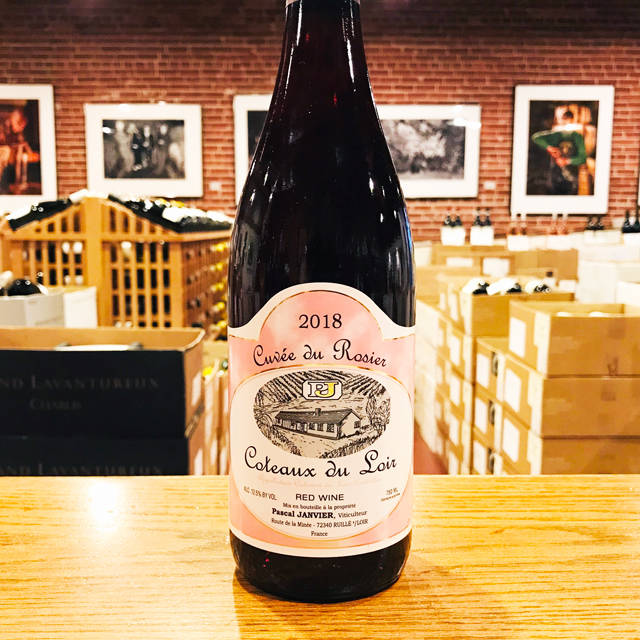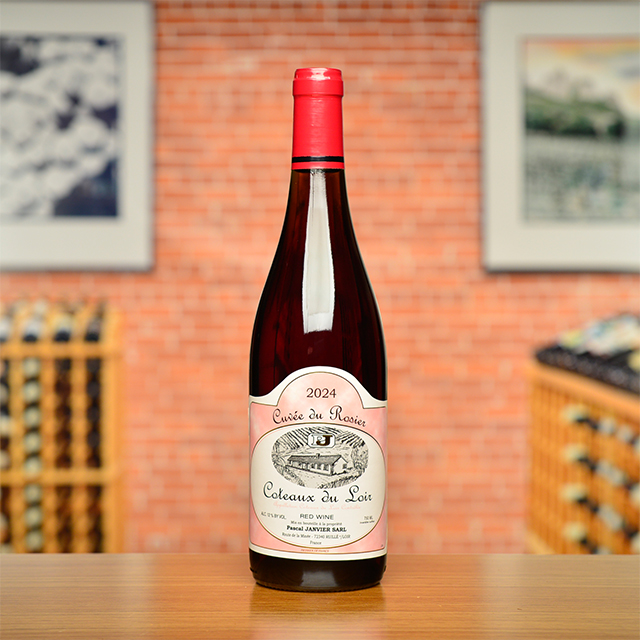Notify me
2018 Coteaux du Loir Rouge “Cuvée du Rosier”
Pascal Janvier
This reasonably priced, delicately flavored charmer is made from 100% Pineau d’Aunis, an indigenous red grape we hold dear to our collective hearts because of its mystifying aromatics, low alcohol, and bright, juicy texture. White pepper, roses, and strawberry fields come to mind, while a subtle palate-tickling spritz livens it up further (this effect is intentional, but if it bothers you, simply shake up the bottle or decant it). A team player at table, this red works well with many diverse cuisines; try it with numbing Szechuan fried chicken for a delicious revelation.
—Anthony Lynch
| Wine Type: | red |
| Vintage: | 2018 |
| Bottle Size: | 750mL |
| Blend: | Pineau d'Aunis |
| Appellation: | Coteaux du Loir |
| Country: | France |
| Region: | Loire |
| Producer: | Pascal Janvier |
| Winemaker: | Pascal Janvier |
| Vineyard: | 25 years, 1.6 ha |
| Soil: | Clay, Sand |
| Farming: | Lutte Raisonnée |
| Alcohol: | 12.5% |
More from this Producer or Region

2024 Jasnières “Cuvée du Silex”
France | Loire
This Chenin Blanc has a tart sweetness, or perhaps a sweet tartness—with neither overbearing—that epitomizes good balance and will have you greedily reaching for your glass.

2022 Jasnières “Cuvée Sainte Narcisse”
France | Loire
It might be the most unusual and most delicious top-quality sweet wine you have ever tried.

2023 Reuilly Pinot Noir
France | Loire
Gently perfumed and full of fresh berries with the bright, stony finish typical of wines from Reuilly

2024 Coteaux du Loir Blanc
France | Loire
Exotically perfumed with hints of guava, musk, and clove, it finishes dry and quite flinty.

2024 Coteaux du Loir Rouge “Cuvée du Rosier”
France | Loire
This red is 100% Pineau d’Aunis, an indigenous red grape we hold dear to our collective hearts because of its mystifying aromatics and bright, juicy texture.

2024 Jasnières
France | Loire
Racy, slightly honeyed, exotically perfumed, and loaded with minerality, this wine is an excellent representation of how Chenin reacts to the local conditions.

2020 Vin de France Rouge Grolleau/Cabernet Franc “Clandestine”
France | Loire
A lovely combination of Grolleau Noir and Cabernet Franc, there seems to be a synergistic effect elevating both grapes to create a juicy, spicy, refreshing whole.

2021 Chinon Blanc “Les Charmes”
France | Loire
The singularity and beauty of Chenin Blanc really shines with a bit of age, which is what makes this wine so special to enjoy now.

2022 Chinon Blanc
France | Loire
Ultra fresh and brimming with citrus blossom and orchard fruit notes, it has a saline, mineral finish that leaves my palate begging for more.

2023 Muscadet Côtes de Grand Lieu sur lie “La Nöe”
France | Loire
At first, it is streamlined, saline, and full of lemon. Then the granite terroir kicks in...
About The Producer
Pascal Janvier
About The Region
Loire

The defining feature of the Loire Valley, not surprisingly, is the Loire River. As the longest river in France, spanning more than 600 miles, this river connects seemingly disparate wine regions. Why else would Sancerre, with its Kimmeridgian limestone terroir be connected to Muscadet, an appellation that is 250 miles away?
Secondary in relevance to the historical, climatic, environmental, and cultural importance of the river are the wines and châteaux of the Jardin de la France. The kings and nobility of France built many hundreds of châteaux in the Loire but wine preceded the arrival of the noblesse and has since out-lived them as well.
Diversity abounds in the Loire. The aforementioned Kimmeridgian limestone of Sancerre is also found in Chablis. Chinon, Bourgueil, and Saumur boast the presence of tuffeau, a type of limestone unique to the Loire that has a yellowish tinge and a chalky texture. Savennières has schist, while Muscadet has volcanic, granite, and serpentinite based soils. In addition to geologic diversity, many, grape varieties are grown there too: Cabernet Franc, Chenin Blanc, Sauvignon Blanc, and Melon de Bourgogne are most prevalent, but (to name a few) Pinot Gris, Grolleau, Pinot Noir, Pineau d’Aunis, and Folle Blanche are also planted. These myriad of viticultural influences leads to the high quality production of every type of wine: red, white, rosé, sparkling, and dessert.
Like the Rhône and Provence, some of Kermit’s first imports came from the Loire, most notably the wines of Charles Joguet and Château d’Epiré—two producers who are featured in Kermit’s book Adventures on the Wine Route and with whom we still work today.
More from Loire or France
2024 Vouvray
Champalou France | Loire
2019 Bourgueil “Les Perrières”
Catherine & Pierre Breton France | Loire
2024 Bourgueil Rosé
Domaine de la Chanteleuserie France | Loire
2015 Chinon “Les Petites Roches” MAGNUM
Charles Joguet France | Loire
Vouvray Brut MAGNUM
Champalou France | Loire
2022 Chinon Blanc
Bernard Baudry France | Loire
2020 Saumur Blanc “L’Échelier”
Thierry Germain France | Loire
2024 Jasnières “Cuvée du Silex”
Pascal Janvier France | Loire
2023 Savennières “Cuvée Spéciale”
Château d’Epiré France | Loire
2020 Sancerre Rouge "Champs d’Alligny"
Daniel Chotard France | Loire
2024 Reuilly “Les Pierres Plates”
Domaine de Reuilly France | Loire
2020 Vin de France Rouge Grolleau/Cabernet Franc “Clandestine”
Grange Saint Sauveur France | Loire
2024 Vouvray
Champalou France | Loire
2019 Bourgueil “Les Perrières”
Catherine & Pierre Breton France | Loire
2024 Bourgueil Rosé
Domaine de la Chanteleuserie France | Loire
2015 Chinon “Les Petites Roches” MAGNUM
Charles Joguet France | Loire
Vouvray Brut MAGNUM
Champalou France | Loire
2022 Chinon Blanc
Bernard Baudry France | Loire
2020 Saumur Blanc “L’Échelier”
Thierry Germain France | Loire
2024 Jasnières “Cuvée du Silex”
Pascal Janvier France | Loire
2023 Savennières “Cuvée Spéciale”
Château d’Epiré France | Loire
2020 Sancerre Rouge "Champs d’Alligny"
Daniel Chotard France | Loire
2024 Reuilly “Les Pierres Plates”
Domaine de Reuilly France | Loire
2020 Vin de France Rouge Grolleau/Cabernet Franc “Clandestine”
Grange Saint Sauveur France | Loire
Kermit once said...

Kermit once said...
For the wines that I buy I insist that the winemaker leave them whole, intact. I go into the cellars now and select specific barrels or cuvées, and I request that they be bottled without stripping them with filters or other devices. This means that many of our wines will arrive with a smudge of sediment and will throw a more important deposit as time goes by, It also means the wine will taste better.
















